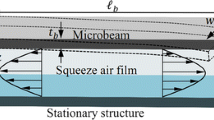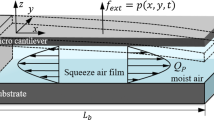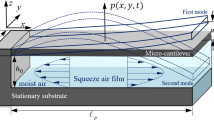Abstract
The external squeeze film damping (SFD) of microelectromechanical systems (MEMS) resonators is a dominant factor to lower the quality factor (Q-factor) due to their large surface area to volume ratio and small spacing. To improve the Q-factor of MEMS resonators, the effect of gas rarefaction (low gas ambient pressure in thin gas film thickness) or operating in higher mode should be considered in SFD analysis. The modified molecular gas lubrication (MMGL) equation is applied for modeling the SFD with gas rarefaction effects taken into consideration. The effects of inverse Knudsen number, surface accommodation coefficients (ACs) and operating frequency on SFD are discussed. The combined effects of SFD, thermoelastic damping (TED) and anchor loss on the total Q-factors of MEMS resonators are considered. The contribution of SFD on the total Q-factor (weighting of SFD) is also discussed. The results show that weighting of SFD could be decrease at low inverse Knudsen number or low ACs or operating at high resonant frequencies.










Similar content being viewed by others
References
Arkilic EB (1997) Measurement of the mass flow and tangential momentum accommodation coeffcient in silicon micromachined channels. Dissertation, M.I.T
Belardinelli P, Brocchini M, Demeio L, Lenci S (2013) Dynamical characteristics of an electrically actuated microbeam under the effects of squeeze-film and thermoelastic damping. Int J Eng Sci 69:16–32
Burgdorfer A (1958) The influence of the molecular mean free path on the performance of hydrodynamic gas lubricated bearings. J Basic Eng-T ASME 81:94–100
Cercignani C, Daneri A (1963) Flow of a rarefied gas between two parallel plates. J Appl Phys 34:3509–3513
Craighead HG (2000) Nanoelectromechanical systems. Science 290:1532–1536
Fukui S, Kaneko R (1988) Analysis of ultra-thin gas film lubrication based on linearized boltzmann equation: first report—derivation of a generalized lubrication equation including thermal creep flow. J Tribol T ASME 110:253–261
Fukui S, Kaneko R (1990) a database for interpolation of Poiseuille flow rates for high Knudsen number lubrication problems. J Tribol-T ASME 112:78–83
Ghaffari S, Ng EJ, Ahn CH, Yang Y, Wang S, Hong VA, Kenny TW (2015) Accurate Modeling of quality factor behavior of complex silicon MEMS resonators. J Microelectromech S 24:276–288
Hamrock BJ (1994) Fundamentals of Fluid Film Lubrication. McGraw-Hill, New York
Hao Z, Erbil A, Ayazi F (2003) An analytical model for support loss in micromachined beam resonators with in-plane flexural vibrations. Sensor Actuat A Phys 109:156–164
Hsia YT, Domoto GA (1983) An experimental investigation of molecular rarefaction effects in gas lubricated bearings at ultra-low clearances. J Lubr Technol 105:120–129
Hwang CC, Fung RF, Yang RF, Weng CI, Li WL (1996) A new modified Reynolds equation for ultrathin film gas lubrication. IEEE T Magn 32:344–347
Ilic B, Yang Y, Craighead HG (2004) Virus detection using nanoelectromechanical devices. Appl Phys Lett 85:2604–2606
Joshi S, Hung S, Vengallatore S (2014) Design strategies for controlling damping in micromechanical and nanomechanical resonators. EPJ Techniques and Instrumentation 1:1–14
Kang SC (1997) A kinetic theory description for molecular lubrication. Dissertation, Carnegie Mellon University
Kim B, Hopcroft MA, Candler RN, Jha CM, Agarwal M, Melamud R, Chandorkar SA, Yama G, Kenny TW (2008) Temperature dependence of quality factor in MEMS resonators. J Microelectromech Syst 17:755–766
Lee JW (2011) Analysis of fluid-structure interaction for predicting resonant frequencies and quality factors of a microcantilever on a squeeze-film. J Mech Sci Technol 25:3005–3013
Leissa AW (1969) Vibration of Plates. NASA, Washington, DC
Li GX, Hughes HG (2000) Review of viscous damping in micro-machined structures. 6th SPIE micromachined devices and components, Santa Clara, CA, 2000, pp 30–46
Li M, Tang HX, Roukes ML (2007) Ultra-sensitive NEMS-based cantilevers for sensing, scanned probe and very high-frequency applications. Nat Nanotechnol 2:114–120
Li WL (1999) Analytical modelling of ultra-thin gas squeeze film. Nanotechnology 10:440–446
Li WL (2002) A database for Couette flow rate considering the effects of non-symmetric molecular interactions. J Tribol T ASME 124:869–873
Li WL (2003) A database for interpolation of Poiseuille flow rate for arbitrary Knudsen number lubrication problems. J Chin Inst Eng 26:455–466
Li WL (2004) Modeling of head/disk interface—an average flow model. Tribol Lett 17:669–676
Li WL (2008) Squeeze film effects on dynamic performance of MEMS μ-mirrors-consideration of gas rarefaction and surface roughness. Microsyst Technol 14:315–324
Lifshitz R, Roukes ML (2000) Thermoelastic damping in micro- and nanomechanical systems. Phys Rev B 61:5600–5609
Mitsuya Y (1993) Modified Reynolds equation for ultra-thin film gas lubrication using 1.5-order slip-flow model and considering surface accommodation coefficient. J Tribol T ASME 115:289–294
Nayfeh AH, Younis MI (2004) A new approach to the modeling and simulation of flexible microstructures under the effect of squeeze film damping. J Micromech Microeng 14:170–181
Pandey AK, Pratap R (2007) Effect of flexural modes on squeeze film damping in MEMS cantilever resonators. J Micromech Microeng 17:2475–2484
Porodnov BT, Suetin PE, Borisov SF, Akinshin VD (1974) Experimental investigation of rarefied gas flow in different channels. J Fluid Mech 64:417–437
Reddy JN (1993) An introduction to the finite element method. McGraw-Hill, New York
Veijola T, Kuisma H, Lahdenpera J (1997) Model for gas film damping in a silicon accelerometer. Solid State Sensors and Actuators, 1997, TRANSDUCERS ‘97 Chicago, pp 1097–1100
Veijola T, Kuisma H, Lahdenperä J, Ryhänen T (1995) Equivalent-circuit model of the squeezed gas film in a silicon accelerometer. Sensor Actuat A Phys 48:239–248
Zener C (1937) Internal friction in solids. I. Theory of internal friction in reeds. Phys Rev 52:230–235
Zener C (1938) Internal friction in solids II. General theory of thermoelastic internal friction. Phys Rev 53:90–99
Acknowledgments
This research was supported by the Ministry of Science and Technology (MOST) of the Republic of China (R.O.C.), Contract Number: MOST 103-2221-E-006-050-MY3.
Author information
Authors and Affiliations
Corresponding author
Appendices
Appendix 1
In the case of flexural vibration of homogeneous rectangular beams, Zener (1937, 1938) have developed a simple approximate expression to estimate \(Q_{TED}\) with various vibrational frequencies (\(\omega_{n}\)) of the thin beams as following
The thermal relaxation times (\(\tau_{R}\)) associated with the transverse thermal modes of the thin beams given by
In the Zener’s the standard theory of TED, the internal friction of the vibrational structures, is analytically given by Eqs. (12) and (13) as functions of the properties of material, thermal relaxation time and vibrational frequency of the thin beams. When \(\omega_{n} \ll \tau_{R}^{ - 1}\), the vibration is isothermal, the vibrational system is remained in thermal equilibrium. When \(\omega_{n} \gg \tau_{R}^{ - 1}\), the vibration is adiabatic, the vibrational system has no time to relax. Thus, there is a little energy dissipated for each case. On the other hand, when the vibrational frequency is very close to the effective thermal relaxation time (\(\omega_{n} \cong \tau_{R}^{ - 1}\)) or (\(\omega_{n} \tau_{R} \cong 1\)), maximum of internal friction of the beam occurs at position of dissipation peak or so-called Debye peak.
Appendix 2
TED, which is one of dominant damping sources in micro-beam resonators, is very sensitive with the mode of resonator. The operating properties of material are used in this comparison with thermal conductivity \(\kappa\) = 90 [W/(m K)], specific heat capacity \(C_{P}\) = 700 [J/(kg K)], thermal expansion coefficient \(\alpha_{S} = 2.6 \times 10^{ - 6}\) (1/K), initial beam temperature \(T_{0}\) = 300 (K). As listed in Table 2, the magnitude of \(Q_{TED}\) varies significantly with the modes of the micro-beam resonator. TED increases and reaches to a maximum value at the 7th mode, and then the \(Q_{TED}\) decreases as the mode of micro-beam resonator increase. That’s because of the internal friction of flexural micro-beam resonator becomes more pronounced when the vibrational frequency is nearly closed to the structural relaxation time (\(\omega_{n} \cong \tau_{R}^{ - 1}\)). Also, the calculated results of \(Q_{TED}\) were compared against with the analytical results that calculate from the model of Zener (1937, 1938) (see Appendix 1) for various flexural modes of micro-beam resonator with the some errors. The errors may come from the simple assumption of Zener’s equation with the structure is very thin and there is no stress perpendicular to the plane. While looking at the 3D model in detail, we found that stresses and their spatial derivations have components of equal magnitude in all three directions. Thus, the results of \(Q_{TED}\) are numerically computed by the 3D model are approximately agreed to that of Zener’s calculation.
Anchor loss is another important damping in MEMS resonators, can also become dominant in higher modes of the resonators. In Table 3, the results of Q-factor of anchor loss (\(Q_{anch}\)) are calculated from the model’s Hao et al. (2003) for various flexural modes of the micro-beam resonator. The values of \(C_{F(n)}\), which is related to various resonant modes, can be obtained from the results of Hao’s paper for various modes of micro-beam resonators. The valid conditions of \({{\lambda_{T} } \mathord{\left/ {\vphantom {{\lambda_{T} } {w_{b} }}} \right. \kern-0pt} {w_{b} }} \gg 1\) in Eq. (9) can be satisfied for various resonant mode conditions. The \(Q_{anch}\) decreases significantly (anchor loss increases) as the mode of resonator increases (higher vibrational frequency).
Appendix 3
In Sect. 2, we proposed the governing equations of the transverse vibration equation (Eq. 2), the MMGL equation (Eq. 5) and the thermal equation (Eq. 8) for the TED and the SFD problem on the Q-factors of the micro-beam resonators. For further derivations, we linearize these equations (Eqs. 2, 5, 8) by assuming small variations for transverse displacement of the beam, gas film pressure and temperature of the beam (\(p_{a}\), \(h_{0}\) and \(T_{0}\) are constants) as
The Poiseuille flow rate may thus be expressed as
The equation for the transverse displacement of the micro-beam (Leissa 1969), Eq. (2), is
with boundary conditions at the fixed edges \(x = 0\)
and at the free edges:
Substituting Eqs. (14), (15) and (17) into Eq. (5), we can obtain the linearized MMGL equation as
The linearized pressure boundary conditions are
The linearized thermal equation for the micro-beam resonators can be obtained as
Thermal gradients are set zero for all the boundaries of the beam
The harmonic variations of the transverse displacement of the beam, gas film pressure and beam temperature are given by
By substituting Eqs. (30) and (31) into Eq. (18), we can obtain
with corresponding boundary conditions
Then we substitute Eqs. (30) and (31) into Eq. (23), we can obtain
with corresponding boundary conditions
Next, we substitute Eqs. (30) and (32) into Eq. (26), we can obtain
with corresponding boundary conditions for themal problem
From the eigenvalue problems of Eqs. (33–39), we can solve the eigenvalue (\(\lambda\)) for the SFD of the micro-beam resonators by the finite element methods (FEM) (Reddy 1993), thus \(Q_{SFD} = \left| {\frac{{\text{Im} (\lambda )}}{{2\text{Re} (\lambda )}}} \right|\). From the eigenvalue problems of Eqs. (33–36) and Eqs. (40-43), we can solve the eigenvalue (\(\lambda\)) for the TED of the micro-beam resonators by the FEM, thus \(Q_{TED} = \left| {\frac{{\text{Im} (\lambda )}}{{2\text{Re} (\lambda )}}} \right|\).
Rights and permissions
About this article
Cite this article
Nguyen, C.C., Li, W.L. Effect of gas rarefaction on the quality factors of micro-beam resonators. Microsyst Technol 23, 3185–3199 (2017). https://doi.org/10.1007/s00542-016-3068-z
Received:
Accepted:
Published:
Issue Date:
DOI: https://doi.org/10.1007/s00542-016-3068-z




